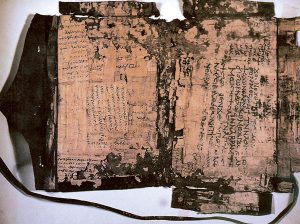
The Nag Hammadi texts were contained in 13 leather-bound volumes discovered by Egyptian farmers in 1945. Dated papyrus scraps used to strengthen the bindings of the books helped date the volumes to the mid-fourth century A.D. Photo: Institute for Antiquity and Christianity, Claremont, CA.
Until the discovery of the Nag Hammadi codices in 1945, the Gnostic view of early Christianity had largely been forgotten. The teachings of Gnostic Christianity—vilified especially since they were declared heretic by orthodox Christianity in the fourth century—had been virtually erased from history by the early church fathers, their gospels banned and even burned to make room for the view of Christian theology outlined in the canonical Gospels of Matthew, Mark, Luke and John.
But when two peasants discovered the Nag Hammadi texts, a 13-volume library of Coptic texts hidden beneath a large boulder near the town of Nag Hammadi in upper Egypt, the world was reintroduced to this long-forgotten and much-maligned branch of early Christian thought, Gnostic Christianity, from the Greek word gnosis, “knowledge.” The Nag Hammadi codices are 13 leather-bound volumes dated to the mid-fourth century that contain an unprecedented collection of more than 50 texts, including some that had been composed as early as the second century.
Our free eBook Ten Top Biblical Archaeology Discoveries brings together the exciting worlds of archaeology and the Bible! Learn the fascinating insights gained from artifacts and ruins, like the Pool of Siloam in Jerusalem, where the Gospel of John says Jesus miraculously restored the sight of the blind man, and the Tel Dan inscription—the first historical evidence of King David outside the Bible.
Once the Nag Hammadi codices had been translated and published by a team of scholars led by Claremont Graduate University’s James M. Robinson, the documents showed that Gnostic Christianity was not the depraved cult described by orthodox Christian writers but rather a legitimate religious movement that offered an alternate testament to Jesus’ life and teachings.
The Nag Hammadi texts, which represent a range of attitudes and beliefs in Gnostic Christianity and include everything from competing gospels to apocalyptic revelations, all assert the primacy of spiritual and intellectual knowledge over physical action and material well-being. The Apocryphon of John, for example, is the most important tractate of classic Sethian Gnosticism. In it the risen Jesus reveals to John, son of Zebedee, the truth of creation.

The Nag Hammadi codices contain more than 50 early Christian texts, including the Gospel of Thomas. The forgotten gospel preserves sayings of Jesus that were not included in the canonical Gospels. Photo: Institute for Antiquity and Christianity, Claremont, CA.
According to this Gnostic myth, the God of the Hebrew Bible is actually a corrupted lower deity. Only through the intervention of Sophia (Wisdom) can gnosis be revealed and salvation attained. Thus, while adherents of Gnostic Christianity certainly acknowledged the role of Jesus in their faith, their theology placed greater significance on the intellectual revelation of his message than on his crucifixion and resurrection.
Also among the Nag Hammadi texts was the fully preserved Gospel of Thomas, which does not follow the canonical Gospels in telling the story of Jesus’ birth, life, crucifixion and resurrection, but rather presents the reader with an early collection of Jesus’ sayings. Although this mystical text was originally believed to one of the early texts of Gnosticism, it now seems to reveal yet another strand of early Christianity.
From a historical perspective, the Nag Hammadi codices provide a clearer picture of the diverse theological and philosophical currents that found expression through early Christianity. Indeed, Gnosticism and its classically inspired philosophical ideals permeated not just early Christian thought but also the Jewish and pagan traditions from which Christianity arose. The Nag Hammadi codices, widely regarded as one of the most significant finds of the 20th century, revealed this complex religious milieu and offered an unparalleled glimpse into alternative visions of early Christianity.
Based on “Issue 200: Ten Top Discoveries,” Biblical Archaeology Review, July/August September/October 2009.
The apocryphal Acts of John describe the dance of Jesus and the apostles. How widespread was the ritual of dance in Christian worship? Read “Jesus as Lord of the Dance: From early Christianity to medieval Nubia” in Bible History Daily.
This Bible History Daily feature was originally published in March 2011.
Get more biblical Archaeology: Become a Member
The world of the Bible is knowable. We can learn about the society where the ancient Israelites, and later Jesus and the Apostles, lived through the modern discoveries that provide us clues.
Biblical Archaeology Review is the guide on that fascinating journey. Here is your ticket to join us as we discover more and more about the biblical world and its people.
Each issue of Biblical Archaeology Review features lavishly illustrated and easy-to-understand articles such as:
• Fascinating finds from the Hebrew Bible and New Testament periods
• The latest scholarship by the world's greatest archaeologists and distinguished scholars
• Stunning color photographs, informative maps, and diagrams
• BAR's unique departments
• Reviews of the latest books on biblical archaeology
The BAS Digital Library includes:
• 45+ years of Biblical Archaeology Review
• 20+ years of Bible Review online, providing critical interpretations of biblical texts
• 8 years of Archaeology Odyssey online, exploring the ancient roots of the Western world in a scholarly and entertaining way,
• The New Encyclopedia of Archaeological Excavations in the Holy Land
• Video lectures from world-renowned experts.
• Access to 50+ curated Special Collections,
• Four highly acclaimed books, published in conjunction with the Smithsonian Institution: Aspects of Monotheism, Feminist Approaches to the Bible, The Rise of Ancient Israel and The Search for Jesus.
The All-Access membership pass is the way to get to know the Bible through biblical archaeology.
The post The Nag Hammadi Codices and Gnostic Christianity appeared first on Biblical Archaeology Society.


0 Commentaires